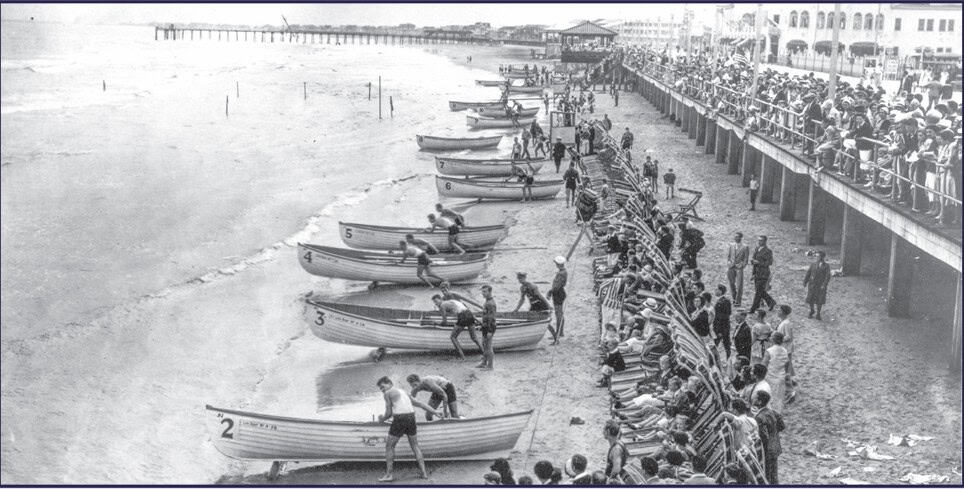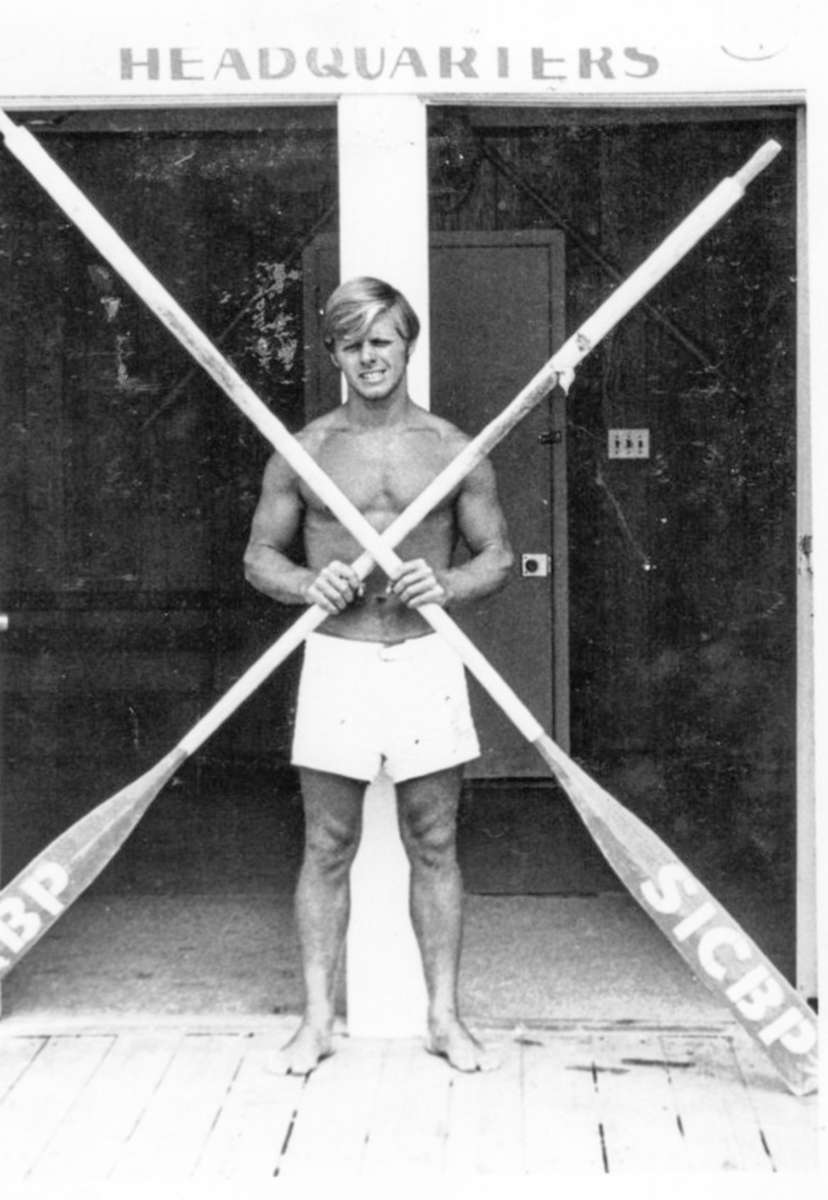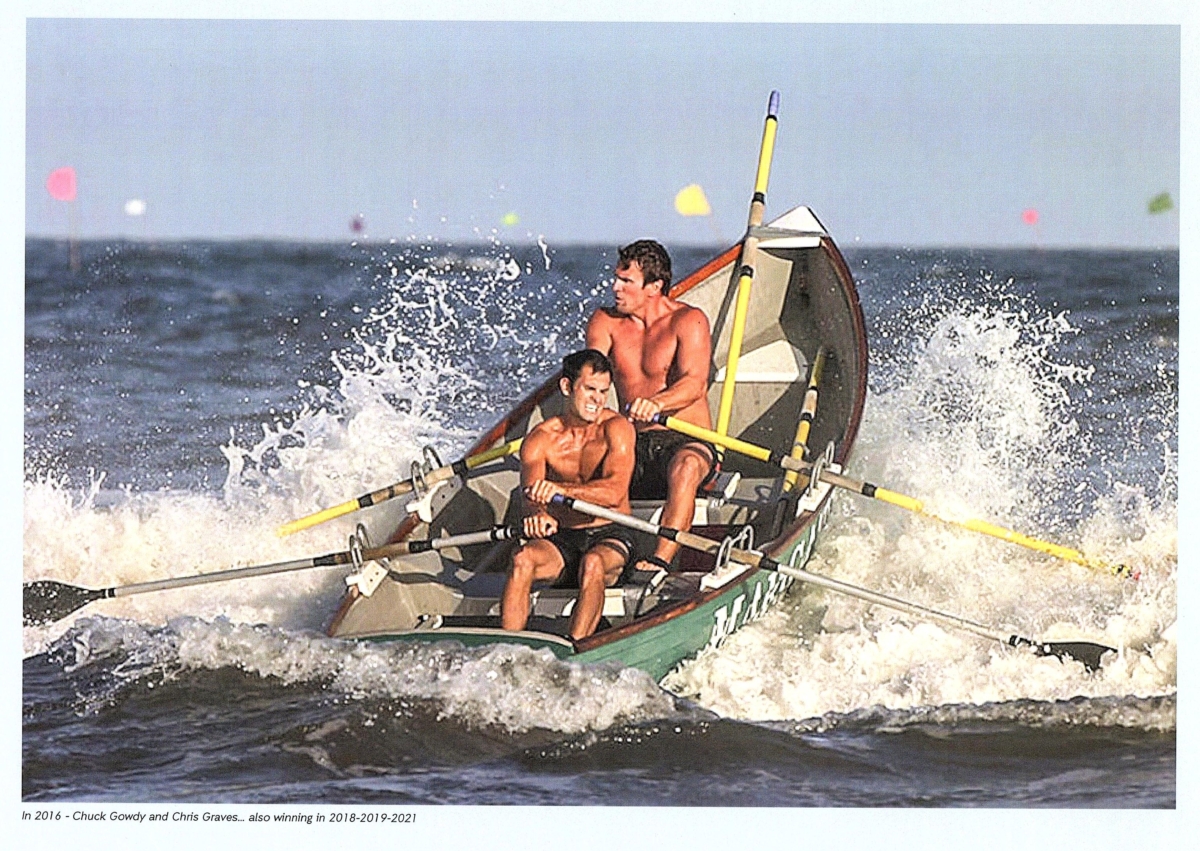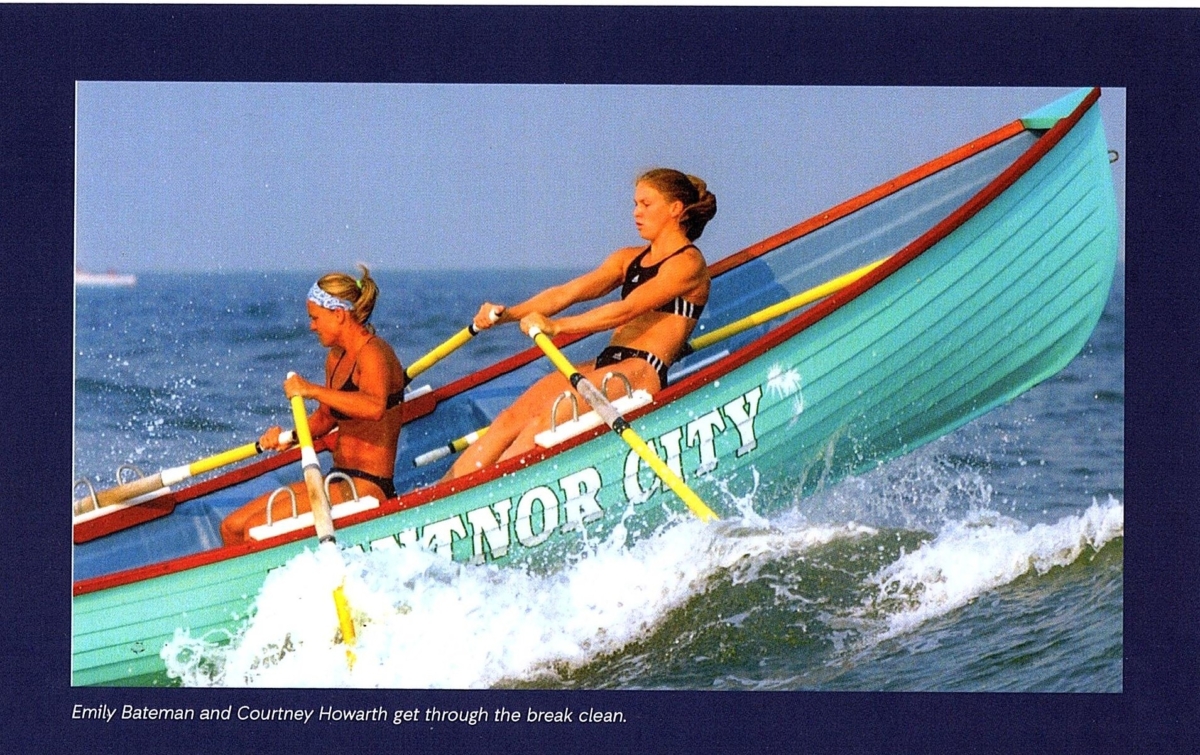Guard Duty

Vineland educator—who spent every summer lifeguarding—publishes a book detailing the rich history of the Jersey Shore patrols, Brigantine to Cape May. BY MICKEY BRANDT
Lifeguard races in Ocean City in 1938 (Photos courtesy Tom McCann)
In the back-cover blurbs for his new book, The Guards, Tom McCann, 73, of Vineland is called an “eternal lifeguard.” His interest began as he watched the guards on the Sea Isle City beaches. He got his lifeguard license in his teens and worked for decades in that role, then as a Beach Patrol captain.
He retired from that front, but continues today as an instructor for rookie lifeguards, a job he
cherishes highest of all. It’s no wonder: McCann is also a lifelong educator; he began as a teacher, then served as an administrator for 36 years, mostly as a principal. He retired from the principalship of Vineland High School in 2018. He’s a storyteller, and occasionally slow to get to the point. But the points are dramatic or humorous and worth the wait.
The book is the first comprehensive one ever written about the 15 South Jersey beach patrols, one of the greatest and valued units in the country. But that’s only the beginning.
Geri Testa McCann edited the book and the designer was Loraine Griffiths.
I had the pleasure of interviewing Dr. McCann recently. The interview has been edited for clarity and space.
———–

The book’s author, as a young lifeguard in Sea Isle City.
Brandt: The book is 192 pages, oversize and hefty, with incredible detail and almost 200 photos. How and why did you tackle such a project?
McCann: I wrote a book a while back with my good friend Billy Howarth Jr. about Sea Isle City Beach Patrol. We released a revision to that, also. After the books on Sea Isle, where I worked most of my career, I heard from South Jersey guards in other places who asked, “Why don’t you write a book about all of us?” I had learned how to do it with that first book and after that, I got so much more information about what could’ve been in the book. I learned a lot from that process and then I decided to do this one.
I want to read from the opening pages of The Guards, then ask a question or two.
The section is called Philosophy of Lifeguarding. This is part of it: “Although the prime concern of any lifeguard operation is the protection of bathers’ lives, it is important to clarify the meaning of “protection.” To protect in this case means not only to rescue from danger, but, primarily, to prevent dangerous situations from developing.
Lifeguards pride themselves in both their ability to save lives through rescue operations and their commitment to the prevention of those situations that may lead to rescues.”
Where did this philosophy—that I know is so important to you—come from?
The legendary Lifeguard Captain Jim King of Brigantine Beach Patrol included it in a lifeguard handbook he published in 1977.
I looked over all the files and the overall philosophies, but his philosophy was most aligned with my own beliefs, and comprehensive. It was very good, so I put it in the front of the book.
What does it mean, preventing situations that may lead to rescues?
Well, the most important thing is to not wait; as soon as you see someone in the water who may be having a problem, you go. You don’t make a decision about it, you do it. My mantra in training guards is “When in doubt, go out.”
And always take the boat. Most situations are no more than holding someone and leading them out of the water or pulling them from a rip tide, guiding them into the boat and bringing them safely to the beach, but you’re ready if you must make a rescue.
You write that most rescues are ultimately caused by carelessness in the water.
The ocean is both beautiful and nasty. Don’t go into it at an unprotected beach; swim in front of the lifeguards. Don’t go into a rough surf. Keep near the shore. Don’t go in alone. Believe it or not, we’ll pull somebody out and find it’s their first time ever at the beach.
Another part of the book’s introduction was your introduction – to lifeguarding and rescues.
Yes, as a young child I had already spent a lot of time on the beach, especially watching the guards do their jobs. I was six years old when I witnessed my first rescue. The reaction I had resonated with me. The rescue left an indelible mark in my mind.
I think a girl fell off a boat.
Yes, the boat was at anchor beyond the surf. I remember how quickly the lifeguards reacted, launching the surfboard and rescuing her. I didn’t know what to do, but I went up the steps to the stand. I thought I was doing something to help just by going up there. I was scared but I now felt strongly connected to lifeguarding because I wanted to help.
And helping is what you did, starting with getting your lifeguard certification at age 15. Did you have a lot of rescues over the decades and did you ever have an unsuccessful one?
Sadly, there were some. There aren’t as many rescues as some people think, but it is the bad ones that can haunt you. We went in after two young children struggling. Each of us went for one and successfully carried them in. But one started calling out “Mommy, Mommy.” She was so far out, we didn’t know she had gone in after them. It was too late when we got there. I rarely talk about this.
You wrote about all 15 South Jersey beach patrols from Brigantine in the north to Cape May Point in the south. Is there one that sticks out?
Atlantic City. It was the first professional lifeguard operation in the United States. It was established in 1891. It created many standards for the other 14 here, and far beyond. It has an exemplary safety record for well over a century. Lifeguarding, and the seminal bather protection systems preceding it, all began in South Jersey.
I was fascinated by the history in your book. Tell us about a highlight or two before we had modern lifeguards.
New Jersey was known as “The Ocean’s Graveyard” in the 18th and 19th centuries because of the shipwrecks. There were more than even Cape Hatteras, North Carolina. As visitors began arriving in the early shore towns, drownings became a new tragedy. Excursion trains to coastal locations began carrying volunteer “lifeguards,” in full uniform to calm the nerves of passengers. Some of the beachfront stores and early hotels provided guards.
New Jersey, and especially South Jersey was the focus of early efforts.
Yes, starting in 1871.
I imagine the job is harder now than it was then because of the huge number of beachgoers.
That’s not so obvious. Church retreats became numerous, and, of course nuns had to wear their habits even in the water—quite dangerous. Also, remember men wore suits that covered their bodies, they became very heavy when water soaked—very hard to lift. One other quick thing, knowing how to swim was a rarity. Now many more people know how.
A large portion of the book is devoted to rowing and other competitions among lifeguards. Why are these activities important?
I think the competitions play an important role for the individual, and for the good of the whole service. The precursor was when lifeguards demonstrated equipment and techniques for the public because it was important for the public to see and feel safer. There are different kinds of competitions. There’s a personal competition in getting to be a better and better rower and all that and some are driven to do that. Then, there are titles in different areas of skill, plus you can get trained on new equipment—let’s see who’s the best.

Chuck Gowdy and Chris Graves winning the South Jersey Rowing Championship in 2016. They also won in 2018, 2019 and 2021.

Emily Bateman and Courtney Howarth get through the break clean.
The book delves into highlights, newspaper clippings, rosters, orders of finish, and ratings of the best—and the legendary—in these competitions. It’s fascinating.
Lifeguards seem a bit on the competitive side. What would they do to win?
Anything. There are area Olympians, some gold medalists, and USA Team champions, many of whom came from South Jersey lifeguarding. My most thrilling event to do was the Surfbash relay. The South Jerseys lifeguard competition is the premier of all championships in the region. The rowing races and the swims are as exciting and competitive as it gets and where legends are made. There are 13 pages about the South Jerseys, including a chart of all the winners since 1919.
This has been a pleasure. Any final thoughts?
Lifeguarding has been my passion forever.
Do you ever think of going back?
I still could.
To purchase The Guards, log onto theguardsbook.com









